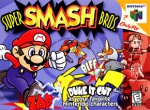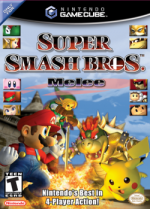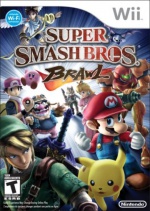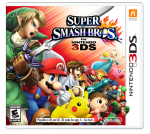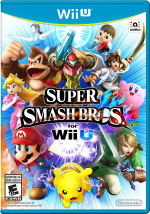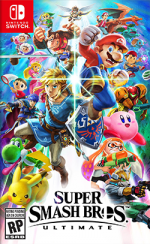Super Smash Bros. (series): Difference between revisions
Torchickens (talk | contribs) No edit summary |
No edit summary |
||
| (14 intermediate revisions by one other user not shown) | |||
| Line 1: | Line 1: | ||
[[File:Smash Bros series logo.png|thumb|right|250px|Logo from ''[[Super Smash Bros. for Nintendo 3DS and Wii U|Super Smash Bros. for Nintendo 3DS]]'']] | [[File:Smash Bros series logo.png|thumb|right|250px|Logo from ''[[Super Smash Bros. for Nintendo 3DS and Wii U|Super Smash Bros. for Nintendo 3DS]]'']] | ||
The '''[[smashwiki:Super Smash Bros. (series)|Super Smash Bros.]]''' (Japanese: {{alttext|大乱闘スマッシュブラザーズ|Great Fray Smash Brothers}}) series, sometimes abbreviated as '''Sumabura''' (Japanese: スマブラ) in Japan, is a series of fighting games published by [[Nintendo]]. It features mainly Nintendo characters (with a few third party characters as of the third and fourth entries in the series) and the main objective of the game is to deal damage (measured in %) and knock characters off the screen. The higher % value a character has, the | The '''[[smashwiki:Super Smash Bros. (series)|Super Smash Bros.]]''' (Japanese: {{alttext|大乱闘スマッシュブラザーズ|Great Fray Smash Brothers}}) series, sometimes abbreviated as '''Sumabura''' (Japanese: スマブラ) in Japan, is a series of fighting games published by [[Nintendo]]. It features mainly Nintendo characters (with a few third party characters as of the third and fourth entries in the series) and the main objective of the game is to deal damage (measured in %) and knock characters off the screen. The higher % value a character has, the easier it is to knock them off the screen. | ||
The original idea for the game originated from a prototype called "''Dragon King: The Fighting Game''" (Japanese: {{alttext|格闘ゲーム竜王|かくとゲームりゅうおう}}), which [[wikipedia:Satoru Iwata|Satoru Iwata]] and [[wikipedia:Masahiro Sakurai|Masahiro Sakurai]] worked on together. Masahiro Sakurai handled the planning, specs, design, modeling and movement and Satoru Iwata handled the programming. <ref>[http://iwataasks.nintendo.com/interviews/#/wii/ssbb/6/0 Iwata Asks : Super Smash Bros. Brawl - Volume 7 : Once in a Lifetime Experience]</ref><ref>[http://www.nintendo.co.jp/wii/interview/rsbj/vol7/index.html 社長が訊く『大乱闘スマッシュブラザーズX』 Vol 7]</ref> When this game was in development, there were originally no Nintendo characters until Nintendo approved to Masahiro Sakurai's idea of adding them. | The original idea for the game originated from a prototype called "''[[smashwiki:Dragon King: The Fighting Game|Dragon King: The Fighting Game]]''" (Japanese: {{alttext|格闘ゲーム竜王|かくとゲームりゅうおう}}), which [[wikipedia:Satoru Iwata|Satoru Iwata]] and [[wikipedia:Masahiro Sakurai|Masahiro Sakurai]] worked on together. Masahiro Sakurai handled the planning, specs, design, modeling and movement and Satoru Iwata handled the programming. <ref>[http://iwataasks.nintendo.com/interviews/#/wii/ssbb/6/0 Iwata Asks : Super Smash Bros. Brawl - Volume 7 : Once in a Lifetime Experience]</ref><ref>[http://www.nintendo.co.jp/wii/interview/rsbj/vol7/index.html 社長が訊く『大乱闘スマッシュブラザーズX』 Vol 7]</ref> When this game was in development, there were originally no Nintendo characters until Nintendo approved to Masahiro Sakurai's idea of adding them. | ||
==Games== | ==Games== | ||
{| | {| | ||
{| align=top style="background: #082567; -moz-border-radius: 0.5em; border: 5px solid #000000;" | {| align=top style="background: #082567; -moz-border-radius: 0.5em; border: 5px solid #000000; color: black" | ||
|- | |- | ||
| | | | ||
| Line 23: | Line 23: | ||
|ニンテンドウオールスター! 大乱闘スマッシュブラザーズ,<br>''Nintendo All-Stars! Dairantou Smash Brothers'' | |ニンテンドウオールスター! 大乱闘スマッシュブラザーズ,<br>''Nintendo All-Stars! Dairantou Smash Brothers'' | ||
|[[nwiki:Nintendo 64|Nintendo 64]] | |[[nwiki:Nintendo 64|Nintendo 64]] | ||
|{{ | |{{releasedateB|Japan|January 21, 1999|USA|April 26, 1999|Europe|November 19, 1999}} | ||
|No relevance | |No relevance. | ||
|- | |- | ||
|''[[smashwiki:Super Smash Bros. Melee|Super Smash Bros. Melee]]'' | |''[[smashwiki:Super Smash Bros. Melee|Super Smash Bros. Melee]]'' | ||
|[[File:Super Smash Bros Melee NA boxart. | |[[File:Super Smash Bros Melee NA boxart.png|150px]] | ||
|大乱闘 スマッシュ ブラザーズDX,<br>''Dairantou Smash Brothers DX'' | |大乱闘 スマッシュ ブラザーズDX,<br>''Dairantou Smash Brothers DX'' | ||
|[[Nintendo GameCube]] | |[[Nintendo GameCube]] | ||
|{{ | |{{releasedateB|Japan|November 21, 2001|USA|December 3, 2001|Europe|May 24, 2002|Australia|May 31, 2002}} | ||
|No relevance | |No relevance. | ||
|- | |- | ||
|''[[Super Smash Bros. Brawl]]'' | |''[[Super Smash Bros. Brawl]]'' | ||
| Line 37: | Line 37: | ||
|大乱闘スマッシュブラザーズX,<br>''Dairantou Smash Brothers X'' | |大乱闘スマッシュブラザーズX,<br>''Dairantou Smash Brothers X'' | ||
|[[Wii]] | |[[Wii]] | ||
|{{ | |{{releasedateB|Japan|January 31, 2008|USA|March 9, 2008|Australia|June 26, 2008|Europe|June 27, 2008|South Korea|April 29, 2010}} | ||
|''[[Super Smash Bros. Brawl]]'' marked the appearance of [[Starfy]] ("Stafy") as an [[smashwiki:Assist Trophy|Assist Trophy]] and [[smashwiki:Trophy|Trophy]], a [[Starly]] ("Stapy") Trophy, as well as [[smashwiki:Sticker|Sticker]]s of Starfy, Starly, [[Moe]] (Kyorosuke), [[Chonmagyo]], [[Mattel]] (Materu), [[Seiuchi-kun]] and [[Herman]] (Yadokarita) | |''[[Super Smash Bros. Brawl]]'' marked the appearance of [[Starfy]] ("Stafy") as an [[smashwiki:Assist Trophy|Assist Trophy]] and [[smashwiki:Trophy|Trophy]], a [[Starly]] ("Stapy") Trophy, as well as [[smashwiki:Sticker|Sticker]]s of Starfy, Starly, [[Moe]] (Kyorosuke), [[Chonmagyo]], [[Mattel]] (Materu), [[Seiuchi-kun]] and [[Herman]] (Yadokarita). | ||
|- | |- | ||
|''[[Super Smash Bros. for Nintendo 3DS and Wii U]]'' | |''[[Super Smash Bros. for Nintendo 3DS and Wii U|Super Smash Bros. for Nintendo 3DS]]'' | ||
|[[File:SSB 3DS | |[[File:SSB 3DS boxart.png|150px]] | ||
|{{ | |{{alttextB|大乱闘スマッシュブラザーズ for Nintendo 3DS|Dairantou Smash Brothers for Nintendo 3DS}} | ||
| | |[[Terminology#N|Nintendo 3DS]] | ||
|2014 | |{{releasedateB|Japan|September 13, 2014|USA|October 3, 2014|Europe|October 3, 2014}} | ||
|Starfy | |Starfy reappears as a regular Trophy and an Assist Trophy | ||
|- | |||
|''[[Super Smash Bros. for Nintendo 3DS and Wii U|Super Smash Bros. for Wii U]]'' | |||
|[[File:SSB Wii U boxart.png|150px]] | |||
|{{alttextB|大乱闘スマッシュブラザーズ for Wii U|Dairantou Smash Brothers for Wii U}} | |||
|[[Terminology#W|Wii U]] | |||
|{{releasedateB|Japan|Winter 2014|USA|Holiday 2014|Europe|Holiday 2014}} | |||
|Starfy reappears as a regular Trophy and an Assist Trophy, and is also an online profile icon | |||
|- | |||
|[[Super Smash Bros. Ultimate|''Super Smash Bros. Ultimate'']] | |||
|[[File:SSB Ultimate boxart.png|150px]] | |||
|{{alttextB|大乱闘スマッシュブラザーズ SPECIAL|Dairantou Smash Bros. SPECIAL}} | |||
|[[Nintendo Switch]] | |||
|December 7, 2018 | |||
|Starfy reappears as an Assist Trophy and online profile icon. Starfy, Starly, Moe, [[Mermaid]], [[Mattel]] and [[Old Man Lobber]] appear as [[ssbwiki:Spirits (characters)|Spirits]]. | |||
|} | |} | ||
|} | |} | ||
Latest revision as of 01:04, 13 January 2019
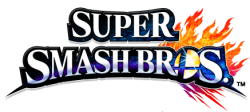
The Super Smash Bros. (Japanese: 大乱闘スマッシュブラザーズ) series, sometimes abbreviated as Sumabura (Japanese: スマブラ) in Japan, is a series of fighting games published by Nintendo. It features mainly Nintendo characters (with a few third party characters as of the third and fourth entries in the series) and the main objective of the game is to deal damage (measured in %) and knock characters off the screen. The higher % value a character has, the easier it is to knock them off the screen.
The original idea for the game originated from a prototype called "Dragon King: The Fighting Game" (Japanese: 格闘ゲーム竜王), which Satoru Iwata and Masahiro Sakurai worked on together. Masahiro Sakurai handled the planning, specs, design, modeling and movement and Satoru Iwata handled the programming. [1][2] When this game was in development, there were originally no Nintendo characters until Nintendo approved to Masahiro Sakurai's idea of adding them.
Games
|
